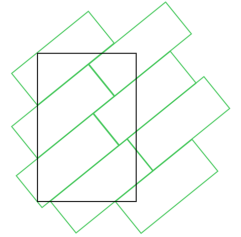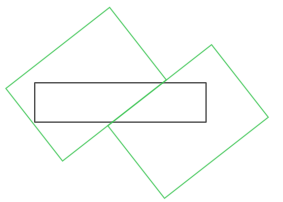Warning: This problem statement contains images that may not be
visible to plugin users. For best results, use the standard Arena editor.
Raccoons dug up your lawn during the spring, but now they've agreed to
resurface it for a modest fee. They come equipped with a turf roller and
a truckload of rectangular turf strips of fixed dimensions. We say that
"length" is the measure of a turf strip's longer edges, while "breadth"
is the measure of its shorter edges. Your lawn is also rectangular: from a
bird's-eye view, what we call "width" is the distance from its left border
to its right border, and "height" is the distance from bottom to top.
For aesthetic reasons, you demand that the turf be laid at a certain
angle. This angle is between 0 and
90 degrees, inclusive, and is measured counterclockwise from the bottom
border of your lawn. In other words, the raccoons will ensure that the
longer edges of every turf strip are inclined at precisely this angle
relative to the horizontal axis.
It may well happen that a single turf strip laid at the desired angle
is not long enough to span your lawn. In such cases, the raccoons lay
several turf strips end to end, precisely aligning the shorter edges
of subsequent strips. At no time will turf strips overlap. Any scraps of
turf that overhang the lawn's borders are immediately trimmed off and
discarded. Once the raccoons have completed their labors, the entirety
of your lawn will be covered with fresh turf.
You are given five integers that respectively state: the width of your
lawn; the height of your lawn; the angle at which turf is to be laid; the
length of each turf strip; and the breadth of each turf strip.
Calculate the minimum number of turf strips that the raccoons
must use in the course of resurfacing your lawn.
| 
